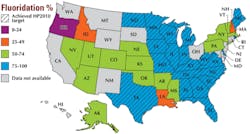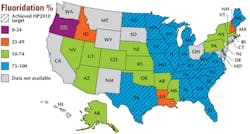Water supply
New trends in community water fluoridation
By Sandra G. Castellanos, RDH, BS, MA
Dental caries is an infectious, transmissible disease in which bacterial by-products (acids) dissolve the hard surfaces of teeth.8,17 Although dental caries is largely preventable, it remains the most common chronic disease of children aged 6 to 11 years and adolescents aged 12 to 19 years old. The National Health and Nutrition Examination Survey, 1999 to 2004, reported that the incidence of dental caries among very young children between the ages of 2 and 6 years old has increased dramatically over the past 20 years. During this time period, 27.9% of children aged 2 years to 6 years had a history of caries in their deciduous teeth. Among those children with decay, 75% had not received any restorative care.
Having dental caries often means a considerable number of visits to the dentist to receive appropriate treatment — treatment that includes repairing or extracting decayed teeth. However, dental caries can be prevented, and the use of fluorides provides the most effective method for its prevention and control.7
Fluoride is a systemic nutrient that can be taken into the body in different ways — by way of water that naturally contains fluoride or has been fluoridated, from prescribed dietary supplements, and from foods. In addition to preventing tooth decay, fluoride is important in bone formation and is used for the treatment of osteoporosis.15,17
According to the Centers for Disease Control and Prevention (CDC), the most cost-effective way to deliver the benefits of fluoride to all residents of a community is through water fluoridation — that is, adjusting the fluoride in the public water supply to the appropriate level for decay prevention while still avoiding enamel fluorosis.14,17
Dental fluorosis in the United States appears mostly in the very mild or mild form — as barely visible, lacy white markings or spots on the enamel. The severe form of dental fluorosis, with staining and pitting of the tooth surface, is rare in the United States.1,2,12
Scientific and professional groups have affirmed the safety of fluoride in drinking water and have not found evidence that shows an association between water fluoridation and a negative impact on people, plants, or animals, if consumed at recommended levels.1,16
Community water fluoridation
Epidemiological and statistical studies provide evidence that support the effectiveness of water fluoridation in preventing dental caries in children and adults.5,9 Moreover, water fluoridation benefits all residents served by community water supplies regardless of socioeconomic status. However, there are some barriers to its implementation: political opposition, tight budgets, certain technical difficulties, and skepticism about its benefits.
For over 65 years, community water fluoridation has been a safe and healthy way to effectively prevent tooth decay. The CDC has recognized the fluoridation of drinking water to prevent dental decay as one of 10 great public health achievements of the 20th century, and a report from the U.S. Surgeon General has stated that community water fluoridation continues to be the most cost-effective, equitable, and safe means to provide protection from tooth decay in a community.6 A study from the CDC found that, “in communities with more than 20,000 residents, every dollar invested in community water fluoridation yields about $38 in savings each year from fewer cavities treated.”7
National goals and guidelines for fluoride use
Healthy People (HP) 2020 recognizes the use of fluoride as a one of the major factors in the decline of the prevalence and severity of dental caries in the United States and other economically developed countries. Although this decline is a major public health achievement, a considerable amount of people in the United States is still affected by this disease. In fact, Healthy People 2020 states, “Only 27 states have met the Healthy People 2010 objective of having 75 percent of their citizens on public water systems with water fluoridation.”
For this reason, Healthy People 2020 Oral-Health Objective OH-13 calls for 79.6% of the U.S. population served by community water systems to have optimally fluoridated water; and OH–9.3 calls for 32.1% of the proportion of school-based health centers to have an oral health component that includes topical fluoride. These dental public health approaches are now part of a national agenda to improve health (Table 1).10,11
New trends in fluoride and recommendations
To date, people in the United States have access to more sources of fluoride than they did when water fluoridation was first introduced to the United States in the 1940s. Now, water is only one of the many sources of fluoride; other common sources include dental products such as toothpaste and mouth rinses, prescription fluoride supplements, and fluoride applied by dental professionals. On January 2011, the U.S. Department of Health and Human Services (HHS) announced a proposal recommending that water systems practicing fluoridation change their fluoride content to 0.7 mg/L, as opposed to the previous temperature-dependent optimal levels that ranged from 0.7 mg/L to 1.2 mg/L.12
Source: CDC - Oral Health Data Systems. Percentage of state PWS population receiving fluoridated water. apps.nccd.cdc.gov/gisdoh/waterfluor.aspx
This updated recommendation was based on the U.S. Environmental Protection Agency (EPA) and HHS scientific assessments that reviewed all possible sources of fluoride, and considered current levels of tooth decay, dental fluorosis, and fluid consumption across the United States. In addition, EPA and HHS balanced the benefits of preventing tooth decay while avoiding adverse health effects.
The American Dental Association (ADA) commended the new government recommendations. It also stated that it will continue advocating for community water fluoridation at the proposed levels, as well as continue reviewing fluoride products for caries prevention through its voluntary Seal of Acceptance program.
In the same way, the CDC stated that it will modify its recommendations as warranted and assess the science regarding the use of fluoride in preventing tooth decay while limiting enamel fluorosis. The CDC believes that community water fluoridation is safe and healthy and promotes its use for people of all ages.16
Dental hygienists are devoted to the prevention of disease and the promotion and improvement of the public’s health. Therefore, dental hygienists should identify strategies to promote effective behavior change and adherence, by adults and health-care providers, to recommendations regarding fluoride use as a safe and useful agent to prevent and control dental caries. In addition, dental hygienists should promote the importance of water fluoridation in order to benefit people of all ages and those who cannot afford or do not have access to dental care.
Sandra G. Castellanos RDH, BS, MA, is an assistant professor in the Dental Hygiene Unit at Hostos Community College in Bronx, N.Y.
References
1. “ADA Positions, Policies & Statements. ADA Statements on Community Water Fluoridation.” www.ada.org/policiespositions.aspx. Web.
2. “ASTDD | Use of Fluoride Community Water Fluoridation.” ASTDD | Homepage. Web. 04 Dec. 2011. www.astdd.org/use-of-fluoride-community-water-fluoridation/.
3. “Basic Information about Fluoride in Drinking Water | Basic Information about Regulated Drinking Water Contaminants | US EPA.” Home | Water | US EPA. Web. 04 Dec. 2011. water.epa.gov/drink/contaminants/basicinformation/fluoride.cfm.
4. “Centers for Disease Control and Prevention (CDC). Advancing the Nation’s Health: A Guide to Public Health Research Needs, 2006–2015. December 2006.” www.cdc.gov/od/science/quality/docs/AdvancingTheNationsHealth. pdf. Web.
5. “Chapter 7: Community and Other Approaches to Promote Oral Health and Prevent Oral Disease.” NIDCR Home. Web. 04 Dec. 2011. www.nidcr.nih.gov/DataStatistics/SurgeonGeneral/sgr/chap7.htm.
6. “Community Water Fluoridation - Oral Health.” Centers for Disease Control and Prevention. Web. 04 Dec. 2011. www.cdc.gov/fluoridation.
7. “Cost Savings - Fact Sheets - Community Water Fluoridation - Oral Health.” Centers for Disease Control and Prevention. Web. 04 Dec. 2011. www.cdc.gov/fluoridation/fact_sheets/cost.htm.
8. Daniel SJ, Harfst SA, Wilder RS. Mosby’s Dental Hygiene: Concepts, Cases and Competencies. Edinburgh: Elsevier Mosby, 2008. Print.
9. Griffin SO, Regnier E, Griffin PM, Huntley V. “Effectiveness of Fluoride in Preventing Caries in Adults.” Journal of Dental Research 86.5 (2007): 410-15. Print.
10. “Healthy People 2010 Home Page.” Healthy People 2020 - Improving the Health of Americans. Web. 04 Dec. 2011. www.healthypeople.gov/2010/hpscripts/KeywordResult.asp?n358=358.
11. “HealthyPeople.gov Oral Health 2020 Topics & Objectives.” Web.
12. “HHS and EPA Announce New Scientific Assessments and Actions on Fluoride.” United States Department of Health and Human Services. Web. 04 Dec. 2011. www.hhs.gov/news/press/2011pres/01/20110107a.html.
13. “Percentage of State PWS Population Receiving Fluoridated Water.” CDC- Oral Health Data Systems. Web. apps.nccd.cdc.gov/gisdoh/waterfluor.aspx.
14. “Recommendations for Using Fluoride to Prevent and Control Dental Caries in the United States.” Centers for Disease Control and Prevention. Web. 04 Dec. 2011. www.cdc.gov/mmwr/preview/mmwrhtml/rr5014a1.htm.
15. Rozarier GR. “Evidence Based Clinical Recommendations on the Prescriptions of Dietary Fluoride Supplements for Caries Prevention.” The Journal of the American Dental Association 141.12 (2010): 1480-489. Print.
16. “Safety - Community Water Fluoridation - Oral Health.” Centers for Disease Control and Prevention. Web. 04 Dec. 2011. www.cdc.gov/FLUORIDATION/safety.htm.
17. Wilkins EM. Clinical Practice of the Dental Hygienist. 10th ed. Philadelphia: Wolters Kluwer Health/Lippincott Williams & Wilkins, 2009. Print.
Table 1
Healthy People (HP) 2020 Oral Health Objectives
OH–9.3: Increase the proportion of school-based health centers with an oral health component that includes topical fluoride.
Target: 32.1%
Baseline: 29.2% of school-based health centers with an oral health component included fluoride rinses, varnish, or supplements in 2007–08.
Target setting method: 10% improvement.
Data source: School-based Health Care Census, National Assembly of School Based Health Care (NASBHC).
OH–13: Increase the proportion of the U.S. population served by community water systems with optimally fluoridated water.
Target: 79.6%
Baseline: 72.4% of the U.S. population served by community water systems received optimally fluoridated water in 2008.
Target setting method: 10% improvement.
Data source: CDC Water Fluoridation Reporting System (WFRS), CDC, ONDIEH, NCCDPHP.
More information: Data from the HHS Health Indicators Warehouse
The HP2010 objective with the same definition was 21-9.
Past RDH Issues

